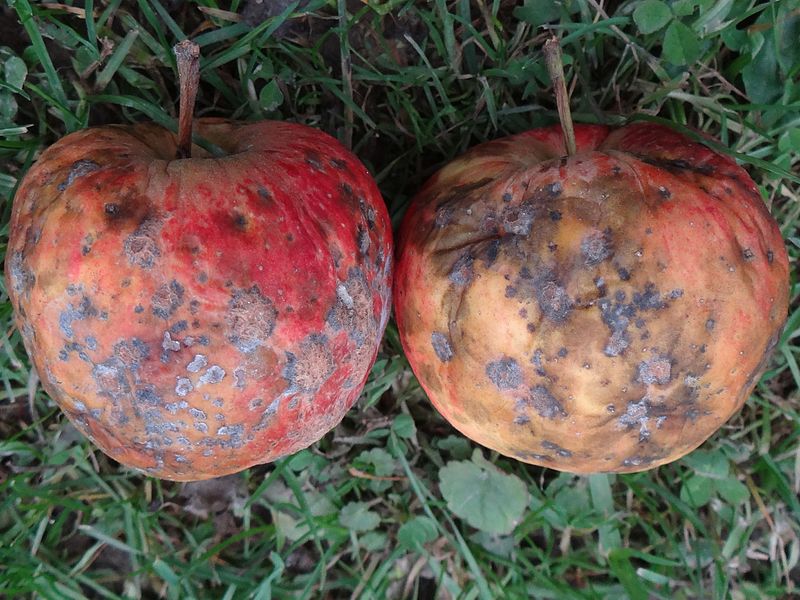Introduction
Apple scab is a fungal disease that commonly infects various apple and crabapple trees. It is recognized as one of the most significant diseases of apples and crabapples. Apple scab infections are capable of disfiguring trees. Severe infections may also reduce or eliminate fruit yield for a single growing season.
Distribution & Habitat
Apple scab may be observed wherever susceptible plants are present. It is most severe in locations that experience abundant rainfall in spring and summer.
Hosts
The apple scab pathogen primarily infects apples and crabapples. Infections may also occur on hawthorns, mountain ash, firethorn, and loquat.
Disease Cycle
Apple scab overwinters on infected leaves that have been shed. During moist periods in spring, spores are expelled from the infected leaves, and disseminated by air currents, splashes of rain, or irrigation to young leaves, twigs, flowers, and fruit, where they initiate new infections. Lesions form on infected sections of the plant. Favorable conditions enable leaf spots to mature, and produce new fungal spores, which are dispersed to nearby leaves, where they create additional infections. Infections may continue to occur throughout the growing season. Abundant rainfall in spring and summer is conducive to scab infection, often resulting in repeated disease cycles that increase the severity of the disease.
Symptoms of Infection
Infections are generally most conspicuous on leaves and fruit. Lesions initially become apparent in spring. They may be observed on the underside of expanding leaves. As the leaves develop, the upper surface becomes vulnerable to infection. Lesions first appear as light green sections on infected leaves. Lesions are generally circular in shape. As the growing season progresses, the lesions enlarge, and deepen in color. Lesions that form on young leaves may exceed 1 cm in diameter. Older leaves are more resistant to infection. As such, lesions that are observed on older leaves tend to be smaller. Infected leaves will often become distorted, with the lesions appearing cracked and torn. Many infected leaves will be prematurely shed, resulting in significant defoliation of the host. Successive defoliations can reduce tree vigor, rendering trees more prone to insect infestations, and infiltration from additional disease pathogens.
Symptoms on plant blossoms are usually characterized as small, dark green lesions at the base of the flower, on the sepals, and on the stem pedicel. Extensive infection of flowers pedicels may cause developing fruit to drop, resulting in a lower fruit yield. The first noticeable symptom of infection on fruit is the appearance of water-soaked areas, which coalesce to form green to brown lesions. Infections of young fruit will often result in fruit distortion. Severely infected fruit may be malformed.
Management
- Many varieties of apple and crabapple are partially resistant or immune to apple scab. Resistant varieties of apple include ‘Dayton’, ‘Freedom’, ‘Honeycrisp’, ‘Liberty’, ‘McShay’, ‘Pristine’, ‘Pixie Crunch’, ‘Redfree’, and ‘William’s Pride’. Varieties of crabapple that exhibit resistance to apple scab include ‘Adams’, ‘Adirondack’, ‘Baskatong’, ‘Bob White’, ‘Calocarpa’, ‘Candywhite’, ‘Christmas Holly’, ‘Coralburst’, ‘David’, ‘Donald Wyman’, ‘Firebird’, ‘Harvest Gold’, ‘Indian Magic’, ‘Indian Summer’, ‘Jewelberry’, ‘Lollipop’, ‘Louisa’, ‘Malus x zumi’, ‘Mary Potter’, ‘Molten Lava’, ‘M. Floribunda’, ‘M. halliana var. parkmanii’, ‘Prarie Maid’, ‘Prariefire’, ‘Purple Prince’, ‘Red Jewel’, ‘Robinson’, ‘Royal Beauty’, ‘Tina’, ‘Sargent’, ‘Silver Moon’, and ‘Strawberry Parfait’.
- Susceptible trees require fungicide sprays every year to control the apple scab fungus. Chemical fungicides are generally utilized for two purposes: as a preventative practice, or as a curative tool. Preventative fungicides are sprayed on the leaves and fruit prior to infection. Fungicidal applications prevent the fungal spores from effectively germinating, or penetrating the host tissue. Curative fungicides express limited systemic activity. If applied shortly after infection, curative fungicides may hinder development of the fungus, limiting disease progression. Initial applications should be performed in spring, as leaf expansion begins. Applications should continue until mid-June, when petal drop occurs. During this period, susceptible foliage and fruit should be inspected for scab lesions. If no leaf spots are present, applications may cease. If scab lesions are detected, applications should proceed until the end of summer. Refer to fungicide labels to determine the recommended spray interval.
- Rake and dispose of fallen leaves in autumn. Infected leaves can be burned or buried.
- Prune trees periodically to improve air circulation throughout the crown. Remove vigorous water sprouts that have formed along the main trunk, or within the canopy to increase sun penetration, and promote rapid drying of the leaves following rainstorms. This will help to create an environment that is less favorable to infection.
Photo courtesy of Jerzy Opiola/CC-by-4.0
